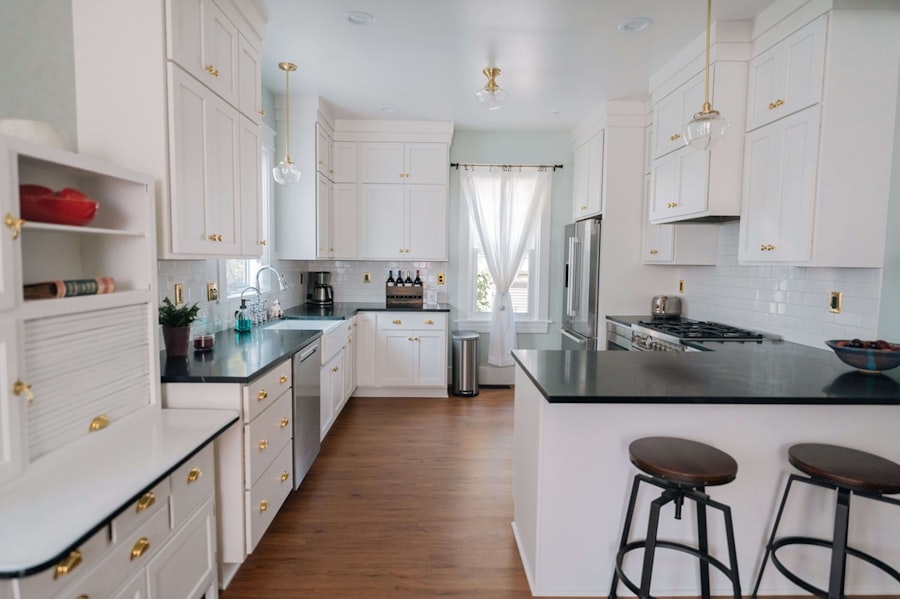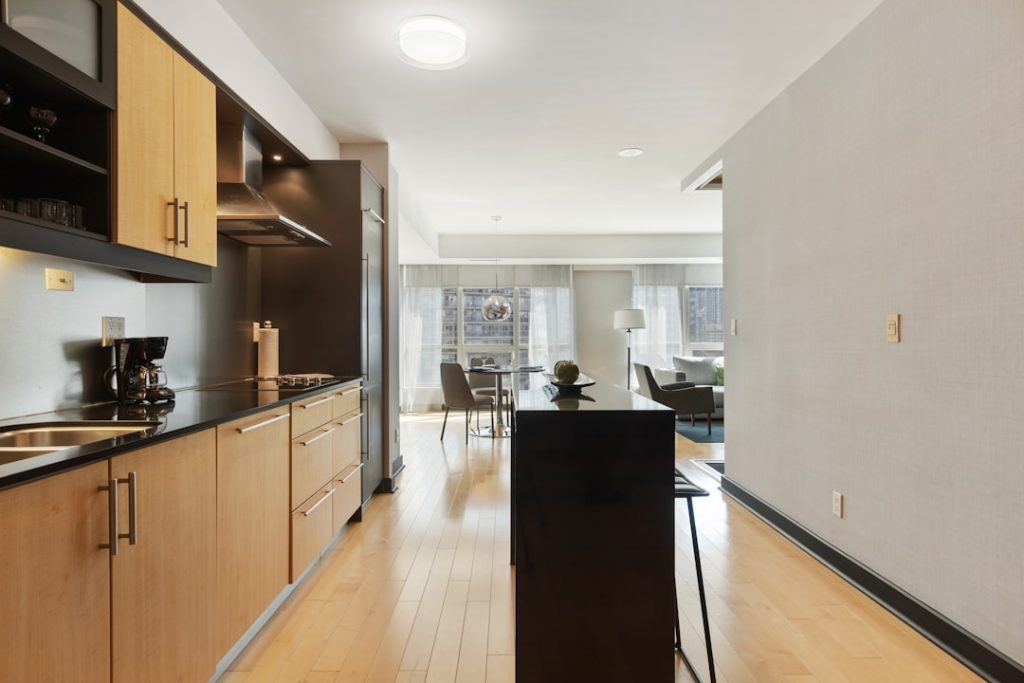Bespoke cabinets are a hallmark of personalized design, distinguished by their unique craftsmanship and tailored fit. Unlike mass-produced cabinetry, which often adheres to standard sizes and styles, bespoke cabinets are custom-made to meet the specific dimensions and aesthetic preferences of the homeowner. This level of customization allows for a seamless integration into any space, ensuring that every inch is utilized effectively.
The process begins with a thorough consultation, where the cabinet maker assesses the client’s needs, preferences, and the overall layout of the kitchen or living area. This initial step is crucial, as it lays the foundation for a design that is not only functional but also visually appealing. The craftsmanship involved in creating bespoke cabinets is another factor that sets them apart.
Skilled artisans employ traditional woodworking techniques combined with modern technology to produce cabinets that are not only beautiful but also durable. Each piece is crafted with meticulous attention to detail, from the selection of high-quality materials to the finishing touches that enhance its aesthetic appeal. This dedication to quality ensures that bespoke cabinets can withstand the test of time, both in terms of functionality and style.
The result is a product that reflects the homeowner’s personality while providing practical solutions for storage and organization.
Key Takeaways
- Bespoke cabinets are custom-made and tailored to fit specific spaces, making them unique and distinct from standard cabinets.
- Customization allows for personalized features such as size, shape, and storage options, ensuring that the cabinets meet individual needs and preferences.
- Designing bespoke cabinets involves finding a balance between aesthetic appeal and practical functionality, drawing inspiration from various sources to create a cohesive and efficient design.
- Selecting the right materials is crucial for ensuring quality and durability, with options ranging from solid wood to high-quality laminates and veneers.
- Working with a professional cabinet maker can help bring your vision to life, offering expertise and guidance throughout the design and installation process.
The Importance of Customization: Tailoring Cabinets to Your Needs
Customization is at the heart of what makes bespoke cabinets so appealing. Homeowners often have specific requirements that standard cabinetry simply cannot fulfill. For instance, a family with young children may prioritize safety features such as rounded edges or soft-close mechanisms, while a gourmet cook might require specialized storage for pots, pans, and spices.
Bespoke cabinets allow for these individual needs to be addressed directly, resulting in a kitchen that not only looks good but also works efficiently for its users. Moreover, customization extends beyond mere functionality; it encompasses aesthetic choices as well. Homeowners can select everything from the cabinet style—be it modern, traditional, or eclectic—to the finish and hardware.
This level of personalization ensures that the cabinets harmonize with the overall design theme of the home. For example, a rustic farmhouse kitchen may benefit from distressed wood finishes and vintage-style knobs, while a sleek contemporary space might call for high-gloss surfaces and minimalist handles. The ability to tailor every aspect of the cabinetry means that homeowners can create a cohesive look that truly reflects their taste and lifestyle.
The Art of Designing Bespoke Cabinets: Finding Inspiration and Functionality

Designing bespoke cabinets is an art form that requires a balance between inspiration and functionality. Homeowners often draw inspiration from various sources, including design magazines, online platforms like Pinterest, or even nature itself. The key is to identify elements that resonate personally while considering how they will function within the space.
For instance, a homeowner might be inspired by the clean lines of Scandinavian design but also want to incorporate elements of warmth through wood textures or color accents. Functionality plays a critical role in the design process as well. It’s essential to think about how the cabinets will be used on a daily basis.
This involves considering not just storage needs but also accessibility and workflow within the kitchen. For example, placing frequently used items within easy reach while storing less commonly used items higher up or further back can significantly enhance efficiency. Additionally, incorporating features such as pull-out shelves, lazy Susans, or built-in dividers can maximize storage potential while keeping everything organized.
The interplay between aesthetic inspiration and practical functionality is what ultimately leads to a successful bespoke cabinet design.
Selecting the Right Materials: Exploring Options for Quality and Durability
| Material Type | Quality Rating | Durability Rating |
|---|---|---|
| Wood | 4.5 | 4.0 |
| Metal | 4.0 | 4.5 |
| Plastic | 3.5 | 3.0 |
| Glass | 4.0 | 3.5 |
The choice of materials is paramount when it comes to bespoke cabinets, as it directly impacts both quality and durability. Homeowners have a plethora of options available, ranging from solid woods like oak, maple, and cherry to engineered materials such as plywood and MDF (medium-density fiberboard). Solid wood is often favored for its natural beauty and strength; however, it can be susceptible to warping in humid environments unless properly treated.
On the other hand, engineered materials offer greater stability and can be designed to mimic the appearance of solid wood at a lower cost. In addition to wood types, finishes also play a significant role in determining the longevity of bespoke cabinets. A high-quality finish not only enhances the visual appeal but also protects the wood from scratches, stains, and moisture damage.
Homeowners can choose from various finishes such as stains, paints, or lacquers, each offering different levels of sheen and protection. For instance, a matte finish may provide a more understated look but might require more maintenance than a glossy finish that repels dirt and grime more effectively. Ultimately, selecting the right materials involves considering both aesthetic preferences and practical requirements to ensure that the cabinets will stand up to daily use.
Working with a Professional: Collaborating with a Cabinet Maker
Collaborating with a professional cabinet maker is an essential step in bringing bespoke cabinet designs to life. A skilled cabinet maker not only possesses the technical expertise required for crafting high-quality cabinetry but also brings valuable insights into design possibilities and material choices. During the initial consultation phase, homeowners should communicate their vision clearly while remaining open to suggestions from the cabinet maker.
This collaborative approach often leads to innovative solutions that may not have been considered initially. Throughout the design and construction process, maintaining open lines of communication with the cabinet maker is crucial. Regular updates on progress allow homeowners to provide feedback and make adjustments as needed.
Additionally, a reputable cabinet maker will often provide detailed drawings or 3D renderings of the proposed designs, enabling homeowners to visualize how their cabinets will look in situ before construction begins. This level of collaboration ensures that the final product aligns closely with the homeowner’s expectations while benefiting from the expertise of a seasoned professional.
Incorporating Personal Style: Adding Unique Touches to Your Custom Kitchen

One of the most exciting aspects of designing bespoke cabinets is the opportunity to infuse personal style into every element of the kitchen. Homeowners can incorporate unique touches that reflect their personality and interests, transforming standard cabinetry into a true expression of individuality. This could involve selecting distinctive hardware—such as antique brass knobs or modern geometric pulls—that complements the overall design theme or choosing custom paint colors that resonate with personal aesthetics.
Beyond hardware and color choices, homeowners can also consider adding decorative elements such as glass-fronted cabinets to showcase cherished dishware or open shelving for displaying cookbooks and decorative items. These features not only enhance visual interest but also create a sense of warmth and character within the space. Additionally, integrating personalized details like engraved cabinet doors or custom carvings can elevate bespoke cabinets from mere storage solutions to works of art that tell a story about the homeowner’s journey and tastes.
Maximizing Space and Storage: Utilizing Bespoke Cabinets for Efficiency
Bespoke cabinets are particularly advantageous when it comes to maximizing space and storage efficiency in kitchens or other areas of the home. Standard cabinetry often falls short in utilizing awkward corners or unusual layouts effectively; however, bespoke solutions can be designed specifically for these challenging spaces. For instance, corner cabinets can be outfitted with lazy Susans or pull-out shelves that make accessing items easier than ever before.
Moreover, bespoke cabinets can be tailored to accommodate specific storage needs based on individual lifestyles. For example, avid bakers may benefit from deep drawers designed for storing mixing bowls and baking sheets, while those who entertain frequently might require wine racks or dedicated spaces for glassware. By analyzing how space will be used on a daily basis, homeowners can work with their cabinet makers to create solutions that enhance both functionality and organization within their kitchens.
The Long-Term Benefits: Investing in Quality Craftsmanship for Your Kitchen
Investing in bespoke cabinets represents not just an immediate enhancement to your kitchen but also a long-term commitment to quality craftsmanship that pays dividends over time. Unlike mass-produced options that may need replacement after just a few years due to wear and tear, bespoke cabinets are built to last using high-quality materials and expert techniques. This durability means fewer replacements and repairs down the line, ultimately saving homeowners money in the long run.
Additionally, bespoke cabinets can significantly increase the value of a home. Potential buyers often view custom cabinetry as a premium feature that enhances both functionality and aesthetics within a kitchen space. As trends shift towards personalized living environments that reflect individual tastes rather than cookie-cutter designs, having bespoke cabinets can set a home apart in a competitive real estate market.
Thus, investing in quality craftsmanship not only elevates daily living experiences but also serves as a strategic decision for future property value appreciation.



